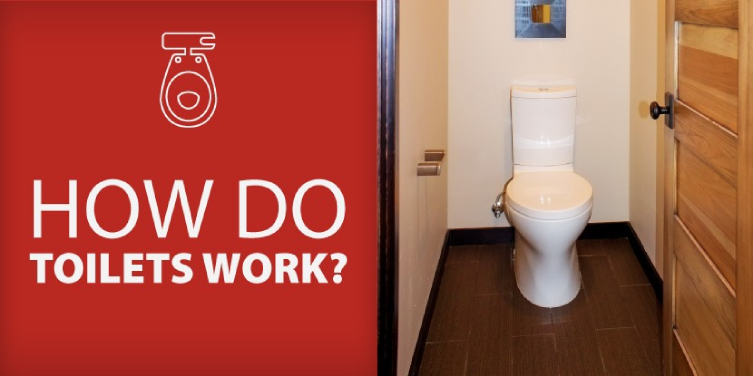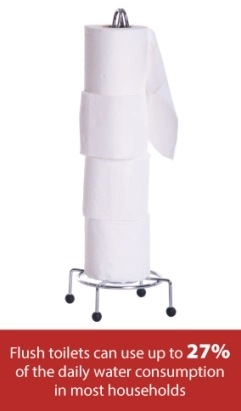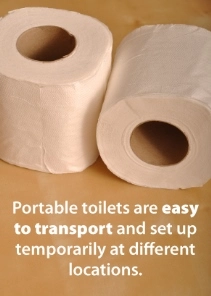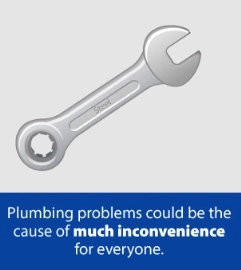
The toilet is referred to by a variety of nicknames, but regardless of what it's called in your house, there's no denying that it's one of the most important devices in any place of occupancy. In fact, it's hard to imagine a building functioning as either a place of business or residence without at least one toilet on every floor.
Still, a toilet is something most people are uncomfortable thinking about, and for rather obvious reasons. After all, toilets take care of human waste, which leads to connotations with germs and stench. The uncleanly atmosphere of so many public restrooms does little to counter the mental imagery that is often conjured by the word "toilet." Setting all of that aside, however, the toilet is a marvel of engineering that makes life easier and more sanitary for people around the world.
For starters, most toilets consist of two main compartments:
- The bowl – drains out into the siphon, and on top sits the toilet seat.
- The tank – placed against the wall like the back of a chair, and features the flush handle. The tank contains the following parts: fill valve, flush valve, overflow tube and flapper.
So how does a toilet work? When a toilet is flushed, the following happens:
- A chain raises the flapper and releases fresh tank water into the bowl.
- Gravity pulls the dirty water through the S-trap and into the sewer or septic tank pipes.
- Once the toilet tank is empty, the flapper shuts and the fill valve activates.
- The tank fills with clean water, which travels up through the base of the valve, through the refill tube, and then back down through the overflow tube.
- The bowl water rises in tandem with the water in the tank. Once the fill line is reached, the valve shuts off and the flushing stops.
The Bowl Siphon
A toilet will flush even without the components of a tank. All that's really needed to make water go up the siphon is more water. For example, if you were to remove the tank from your toilet, the bowl itself could still do the job of taking waste to the sewer. The thing that actually makes a toilet flush in the first place is the curve of the siphon — the tank and handle merely make the whole process easier.
In case you can't imagine how a toilet bowl could flush itself without the presence of a tank, there's a simple experiment with which you can witness the wonders of the toilet's unique design:
Pour a tall glass of water into your toilet, and watch to see if the water level rises. Notice how it doesn't. That's because the added water has sent the water level over the siphon. You can try it again and again, but it will still be the same. The siphon sets a limit for how much water the bowl will store at any given time.
Now try something a little bit different. Pour a large cooking pot full of water into the toilet and see what happens. This time, the bowl does a full-blown flush, despite the fact you didn't even pull the handle. When this happens, it's because the siphon tube has gotten all filled up, which causes the siphon to suck all the water from the bowl. As all this occurs, the siphon tube fills with air, and the unmistakable flushing sound is heard.
The Flush Mechanism
As was shown in the water pot experiment, a toilet will flush without a tank. In fact, you don't even need running water to get a pot to flush. A several-gallon supply of packaged water could adequately do the trick. The trouble is, it would all become tiresome if you had to fill a toilet pot with water after every trip to the bathroom. For that reason, toilets are equipped with tanks, which function as automatic water pots — sending and gathering water and sparing you the trouble.
When people learn about how flushing occurs, there's one question that often springs to mind: Why must tanks be so big? Wouldn't a faucet-sized stream be enough? The answer is no. A spout that runs water at the same volume as a sink, for instance, wouldn't produce enough speed or pressure to activate a siphon like the water stored in a toilet tank.![]()
Therein lies the purpose of the toilet tank. Their job is to store gallons of water at a time, and they drop it all into the toilet pot within seconds of the handle being pulled. Thanks to all of that water power, the numerous things that go into a toilet —food, tissues, waste, etc.— magically disappear within seconds of each flush.
The inner workings of the tank form the most complex part of the toilet. Most of the time, however, the only part of the tank that people deal with is the handle, which is connected on the inside to a chain that links to the flush valve.
When the handle is pulled, the chain gets tugged, which in turn opens the valve. The opening of the valve exposes a hole — two to three inches in diameter — through which water pours into the bowl. The water comes down from the inner-rim, and most of it goes out the siphon jet, taking all the waste in the process. Because of the speed and pressure at which this occurs, the siphon is instantly activated — just as it would be with a full bucket of water.
The Refill Mechanism
As you now know, a flush occurs when enough water fills the bowl to trigger the siphon. The tank's function is to send enough water — roughly two gallons — through the bowl within 30 seconds to make that flush happen with a pull of the handle. Once the water supply has drained from the tank, the flush valve shuts so new water can be collected for the next flush. This is where the refill mechanism fulfills its role in the process.
The refill mechanism is equipped with a valve that activates the water supply. The whole process, meanwhile, is signified by the float ball, which drops to half-mast when the tank empties, and then rises up to the filler valve once the tank is completely refilled. While this is happening, water is also going down the overflow tube to refill the bowl.
The float ball — also known as the filler valve — and the overflow tube work together during this process to keep the water level even. The former lets the fill valve know when to start and stop loading water, while the overflow tube directs excess water to the right places. If the float ball comes detached and the tank starts to load water continuously, the overflow tube will redirect excess volumes of water into the bowl to prevent the tank from overflowing. When a flush never seems to end, it's often due to an issue along these lines.
The History of Toilets
The earliest known toilets date to around 2800 BC, during the Age of Cleanliness. The remains of the most advanced toilet designs from this period are found in the Mohenjo-daro archaeological site of modern-day Sindh, Pakistan, where toilets were built from brick and consisted of wooden seats. These toilets connected to downward chutes that released waste into cesspits. However, use of these toilets was restricted to the upper classes. Everyone else had to squat. Also during the third millennium, people in northwestern India had toilets with running water that flowed into brick-covered drains.
In the Neolithic settlement of Skara Brae on the Scottish island of Orkney, houses built between 3100 BC and 2500 BC contained toilets with running water that connected to cubicle-covered drains. Early during the second millennium, toilets became a part of life in Minoan Crete, Egypt. In recent years, archeologists have uncovered the remains of what is believed to be a latrine-style toilet in Viet Nam that dates from around 1500 BC.
During the Middle Ages, toilets used by the upper class were known as garderobes. The garderobe consisted of a flat panel of wood with a hole in the center. In most castles, the panel was placed between opposite walls, in an area away from bedrooms. Each garderobe connected to a chute that released waste to an outer manor.
In ancient Rome and Greece, the commoners used chamber pots, which were placed in receptacles along the streets of cities. The chamber pot varied in size and shape, but it was usually made of either ceramic or metal. The design evolved over several centuries, during which chamber pots were imported to the Middle East and came to be made of copper and china.
Prior to the invention of flush toilets, chamber pots were used as nighttime waste repositories, and the "nightsoil" — as waste was often called — was dispensed with at dawn. While the design has generally been abandoned in developed countries over the past few centuries, it has seen continued use in UK prisons, as well as in the form of hospital bedpans.
The 16th century witnessed vast population growth throughout the cities of Europe, which spurred the development of cesspits in urban areas. In order to account for the fact that rain could no longer remove the vast amounts of human waste that was now being produced, a new system was developed in which latrines and cesspools were connected via pipes. Workers would clean out these cesspools with shovels every night, and then cart off the hard remains, which would subsequently be used as fertilizer.
For the remainder of the waterless-toilet era, waste was recycled into agriculture in a manner similar to the animal kingdom. During the early 1800s, health officials were debating on whether it was really sanitary to recycle human waste. By the middle of the 19th century, cesspools were being replaced by modern-day sewage systems in most major cities. As this was happening, plumbing for sinks, tubs and toilets also became commonplace in houses and apartment buildings.
The flush toilet that people use today was first developed during the Industrial Revolution. Spurring this development was Scottish watchmaker Alexander Cummings, who advanced the capabilities of plumbing with his invention known as the S-trap in 1775. With this design, it was now possible to let waste drain from a toilet to the sewer because the sitting water within a bowl worked at blocking out sewage stench.
Flush toilets quickly became popular throughout the U.K., Europe and North America. One of the distinct innovations among U.S. engineers during the late 1800s was the chain-pull indoor toilet, which was used in upper-class homes and hotels prior to the flush toilet. A further innovation arrived at the turn of the century in the form of the Flushometer, which linked toilets to pressurized water and thus shortened the wait time between flushes.
Since that time, the standard flush toilet has reigned supreme throughout most of the world. Recent decades, however, have brought about significant developments in the design, and one of the most notable has been the Duoset cistern by Australian inventor Bruce Thompson. Featuring two buttons and flush levels, the Duoset has allowed users to conserve as much as 67% on their water.
Prior to the spread of flush toilets, many prominent inventors and health officials promoted the use of dry earth closets, which were invented in the mid-19th century by clergyman Henry Moule. He sought to improve London's sanitation after two cholera outbreaks were caused by sewage buildup in the Thames.
His design was inspired by the facilities used at the care houses that treated patients during the Great Stink of 1858, which culminated from the sewage problem. Though it never caught on universally, Moule's system — which he expounded upon at length in several written works during the 1870s — was put into place for a number of years at private homes, hospitals and military outposts.
Different Types of Toilets
Toilets have evolved over millennia across multiple continents. Even today, toilet designs continue to evolve as technologies improve and users demand a broader array of features and functionality. The following toilet types represent the most widely used and noteworthy designs around the world:
Flush toilet – The most common toilet design throughout the developed world today is the flush toilet, which consists of a tank, a bowl, a seat, a lid and a siphon tube that leads to a drainage system. The siphon, with its upside-down U-shape, is one of the most beneficial designs of engineering because it keeps the level of water in the bowl consistent. In addition to flushing out waste and mitigating germs and odor, bowl water also locks out sewer gas from the drainage pipes. Most toilets drain into neighborhood sewers or septic tanks.
Flush toilets can use up to 27 percent of the daily water consumption in most households, though some of the newer models are designed to conserve water. Toilets with lower flush levels, for instance, reduce the amount of water consumed on an average day.
Another design that lowers water consumption is the dual-flush toilet, which allows a user to choose between liquid and hard-waste flushing. In some establishments, water is conserved by reusing gray water — the water from appliances like dishwashers and washing machines — in all on-premises toilets.
The majority of flush toilets around the world are made of porcelain, which consists of a clay and water mixture that's blazed at high temperatures. Most of the clay used is of kaolinite origin, but minerals like alabaster, feldspar, petuntse, quartz and steatite are also sometimes part of the makeup.
Pit toilet – Also known as the pit latrine, the pit toilet is a makeshift, outdoor unit that can range from a trench in the soil to a squatting pan. Pit toilets are most common in rural areas and in poor, developing countries. In many cases, pit toilets are set up for emergency relief. Army troops will often use pit toilets when deployed in locations far removed from regular plumbing systems. For sanitation purposes, pit toilets need to be placed at a safe distance from streams that supply drinking water. Before World War II, however, pits were often ill-placed in warzones, which caused diseases that killed more soldiers that bombs, guns or tanks.
Vault toilet – A flush-free compartment buried underground where hard waste is stored and eventually plumbed, but where liquid waste is drained into the soil. Vault toilets are usually placed within a small outhouse.
Dry toilets – Flushing without water, dry toilets come in a variety of designs. Examples include the following:
- Composting toilet – decomposes waste by adding carbon elements

- Freezing toilet – one that freezes waste
- Incinerating toilet – burns waste
- Pit latrine – a hole in the ground
- Tree bog – turns hard waste into fertilizer
Chemical toilet – Standard in passenger vehicles such as airplanes and trains, chemical solutions are used in toilets in lieu of water due to the lack of a running water supply.
Flying toilet – How do tankless toilets work? When it's all in a bag, you don't even need a tank. The flying toilet is not really a "toilet" at all — just a practice in certain parts of Africa where people defecate into plastic bags, and then toss the bags as far away as possible. The flying toilet practice has led to sanitation problems due to the human waste and littered plastic that has accumulated in certain rural parts of the continent. For those reasons, the types of plastic bags that have given rise to this phenomenon are now banned in Kenya, Tanzania and Uganda.
Portable toilet – Alternately known as porta pots, portable toilets are single-unit, unisex facilities that are often seen at construction sites, county fairs and other outdoor events in remote locations. Portable toilets are named as such because they're easy to transport via truck and set up temporarily at different locations on an as-needed basis. The portable enclosure consists of a plastic toilet, waste receptacle and a lockable door. Portable toilets flush with chemical disinfectants. Receptacles are emptied daily and cleansed on a regular basis. 
High-tech toilets – Today's tech-savvy and financially well off homeowners have the option of toilets that offer a host of advanced features, including auto-flush, bottom washers and dryers, noise concealers, deodorizers, automatic seat-sheet replacement and seat heaters. Some of the most high-tech units on the market, like Matsushita's Smart Toilet, offer basic health reports based on analysis of bodily waste.
Floating toilets – Floating toilets are an alternative to grounded toilets for people who live in areas with limited land space, and also where communities are often vulnerable to flooding and typically lack plumbing. With a floating toilet, waste is stored in a tank and later expunged. Some units even divert liquid waste into separate systems.
How to Handle Toilet Problems

The toilet is one of the most important things you have in your home. Whether you live a house of one, two, three, four or any given number of people, there's a toilet that's probably used regularly when the house is occupied. Therefore, plumbing problems could be the cause of much inconvenience for everyone, regardless of whether such issues occur in the daytime, nighttime or on a weekend.
Throughout the Syracuse area, residents and businesses are able to rest assured knowing that plumbing issues can be remedied around the clock with a simple phone call to Mr. Rooter Plumbing of Greater Syracuse, which offers emergency service day or night, 24/7.
The toilet, as it is known to most Americans, features a simple yet complex design. As such, a number of different things can malfunction with a toilet, whether the issue stems from a worn tank part or clogged siphon. Sometimes the problem comes down to misuse, while in other cases it's a purely technical mishap. In either situation it's crucial to have professional help on the double to remedy the matter and restore the toilet to its optimal working functions. For decades, the licensed plumbers of Mr. Rooter Plumbing have provided same-day toilet repairs in houses, apartments and office buildings in Onondaga County.
Don't allow toilet problems to put a cramp in your day. When an issue arises with the function of your toilet, call the plumbing experts at Mr. Rooter Plumbing.

